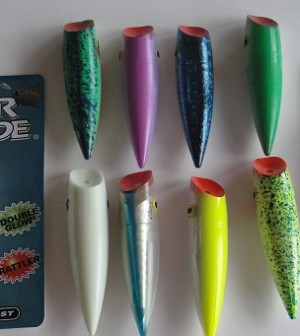How to Fish Salmon Plugs

The art of fishing salmon plugs has been a favorite among both commercial and sports anglers for years. During the 40’s, 50’s and 60’s if you planned on winning a salmon derby, you probably were fishing a plug. While plugs are still popular with skilled anglers, with the new colors, finishes and actions of spoons, many anglers now overlook the advantages of plugs.
Some of the advantages of plugs are as follows:
- They now have the same colors, UV and Glo finishes that spoons do.
- Plugs “match the hatch”! In the winter, salmon feed heavily on the squid that enters Puget Sound to spawn. In the summer fishery, in an area with larger herring, once again a plug matches the size of the available bait in the water.
- Plugs are best fished on a line, by themselves, not behind a flasher. So, you don’t have the drag of a flasher when a salmon is hooked, thus a more enjoyable fight.
- Last, but certainly not least, you catch fewer salmon, but larger salmon and fewer shakers.
So how do we fish plugs most effectively?
The first thing to go in the water on my boat is a line with a flasher, trailing a Silver Horde spoon, a Gold Star Squid or a Pro Troll E-Rotary Bait Holder, with either a brined herring or herring filet.
Nothing attracts more salmon than a flasher and the sound (vibrations) it creates. But plugs, except in a few situations are not designed to be fished behind flashers.
On the opposite side of the boat I will drop a plug. If fishing by myself (thus one rod out) you can add attraction by using what is often referred to as “The Ace in the Hole” or “False Flasher” method. That is simply attaching a flasher directly to your downrigger ball without an attached lure! Drop your “False Flasher” back to 6’ to 10’ behind your downrigger ball. Run your line release with the plug 10’ above your “False Flasher”. Ten feet above that drop your plug back 25’ to 35 feet from your release.
If fishing two rods, drop your flasher and lure back 20 to 25 feet behind your release. This will be your deep rod. On the opposite side, drop your plug 10’ higher and back 35 feet.
 If a salmon doesn’t hit your lure on the flasher, underwater videos show that salmon almost always turn up and away, thus the plug trailing further back is now in their strike range. This is when you can get hard, strong strikes as the salmon is hitting the plug as it is going away.
If a salmon doesn’t hit your lure on the flasher, underwater videos show that salmon almost always turn up and away, thus the plug trailing further back is now in their strike range. This is when you can get hard, strong strikes as the salmon is hitting the plug as it is going away.
One more hint is when you bring your lures up to check them, break your plug loose first and let it float to the top, as it will retain its action and float to the top. Stick the plug rod back in a rod holder. Then bring your flasher unit up, by using your downrigger. That way you won’t tangle lines. I add 5-6 Chinook to my boat every year that hit while the plug is floating to the surface.
 I fish my plugs on my reels’ line with a Sampo Ball Bearing Swivel, attached about 6 ft above the plug. I use 25 lb leader from the swivel to the plug. Because of the barbless hook regulations, a twisting, jumping salmon is less likely to throw the hook.
I fish my plugs on my reels’ line with a Sampo Ball Bearing Swivel, attached about 6 ft above the plug. I use 25 lb leader from the swivel to the plug. Because of the barbless hook regulations, a twisting, jumping salmon is less likely to throw the hook.
My best plugs are the Silver Horde 4 & 5 inch plugs with a cupped face. My favorite colors in Silver Horde plugs are dark green in various shades in the winter. Lighter greens and whites are great for summer fishing. Also, always fish a rattle plug. Once again noise attracts fish.










